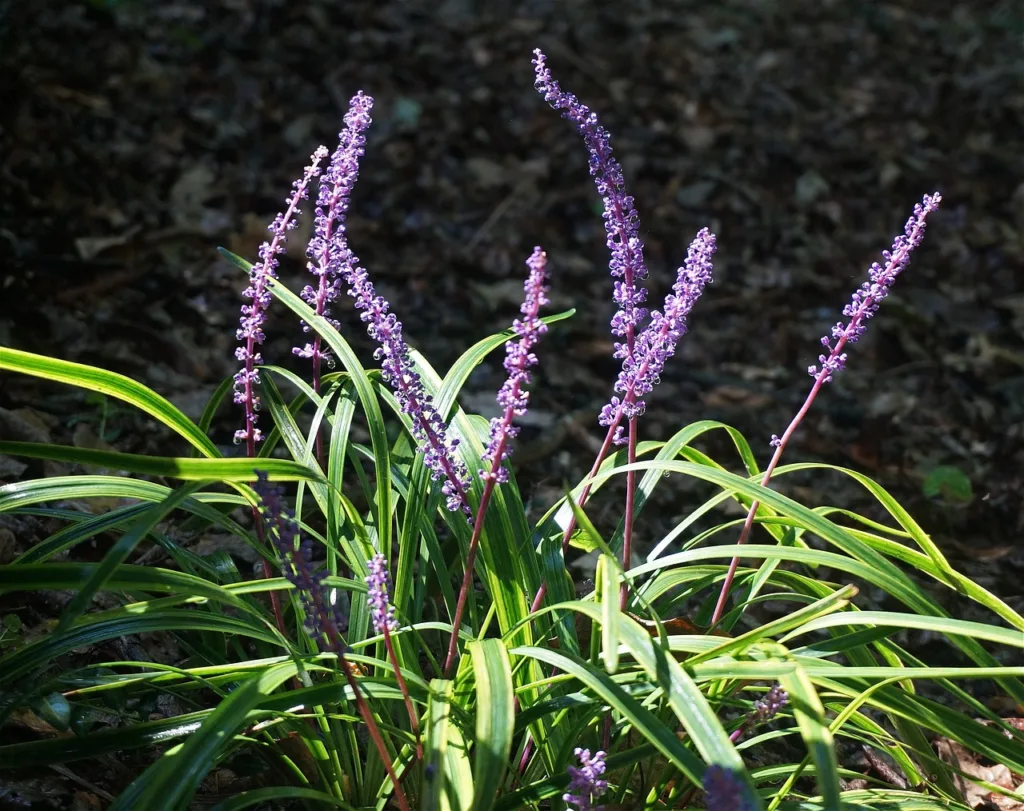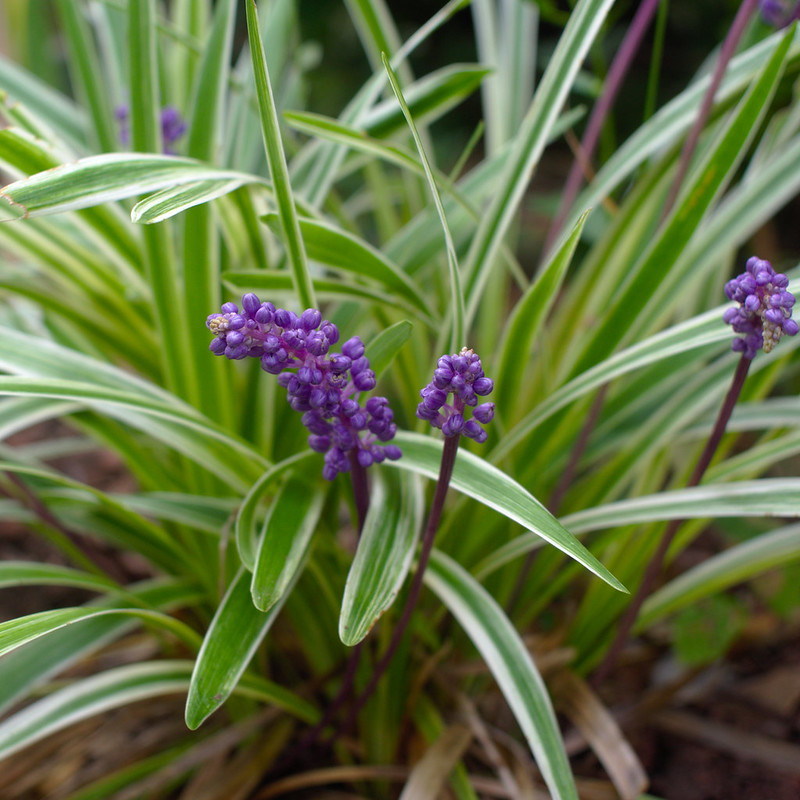Are you looking to add a touch of beauty and elegance to your garden? Variegated Liriope might just be the perfect choice for you!
With its lush green foliage and stunning variegated leaves, this perennial grass-like plant can enhance the visual appeal of any outdoor space.
Whether you’re a seasoned gardener or a beginner, growing and caring for Variegated Liriope is a breeze. In this comprehensive guide, we will delve into the step-by-step process of cultivating and maintaining this captivating plant. So let’s get started!
Getting to Know Variegated Liriope
Before we dive into the nitty-gritty of growing and maintaining Variegated Liriope, let’s take a moment to familiarize ourselves with this beautiful plant.
Variegated Liriope, also known as Liriope muscari ‘Variegata’, is a perennial grass-like plant that belongs to the Asparagaceae family.
It is native to East Asia and is known for its striking variegated leaves, which feature a combination of green and creamy white streaks. This unique coloration adds a touch of vibrancy to any garden or landscape.
Design Ideas:
- Edging and Borders:
- Use Variegated Liriope to create neat borders along pathways or garden beds, providing a refined and polished look.
- Mass Plantings:
- Plant Variegated Liriope in masses to form a ground cover, particularly in shaded areas where its variegation can brighten up the space.
- Container Gardening:
- Showcase the elegance of Variegated Liriope in containers, either alone or as part of a mixed arrangement, adding a touch of sophistication to patios and decks.
| Attribute | Details |
|---|---|
| Botanical Name | Liriope muscari |
| Common Name | Variegated Liriope, Variegated Lilyturf |
| Plant Type | Perennial |
| Foliage | Evergreen, Variegated |
| Foliage Color | Green with Cream or Yellow Stripes |
| Mature Height | Typically 12 to 18 inches |
| Spread | Spreading Habit |
| Hardiness Zones | USDA Zones 5 to 10 |
| Light Requirements | Partial to Full Shade |
| Soil Type | Well-Drained, Adaptable |
| Toxicity | Generally Non-Toxic |
| Landscaping Uses | Ground Cover, Borders, Edging, Containers, Erosion Control |
| Growing Conditions | Prefers Moist, Well-Drained Soil |

Choosing the Right Location
Like any other plant, Variegated Liriope thrives in the right growing conditions. When selecting a location for your plant, keep in mind that it prefers partial shade to full shade.
Direct sunlight can scorch its delicate leaves, so it’s best to find a spot that offers some protection from the sun, such as under a tree or near a building.
Additionally, ensure that the soil is well-drained and has a pH level between 5.5 and 7, as Variegated Liriope prefers slightly acidic to neutral soil.
Preparing the Soil
Now that you’ve chosen the perfect spot for your Variegated Liriope, it’s time to prepare the soil. Start by removing any weeds or debris from the area.
Next, loosen the soil using a garden fork or tiller to a depth of approximately 8 to 12 inches. This will improve the soil’s drainage and allow the plant’s roots to penetrate easily.
If your soil is heavy or clayey, consider adding organic matter such as compost or well-rotted manure to enhance its structure and fertility.
Planting Variegated Liriope
Once you’ve prepared the soil, it’s time to plant your Variegated Liriope. Begin by digging a hole that is twice the width of the plant’s root ball and just as deep.
Gently remove the plant from its container, being careful not to disturb the roots too much. Place the plant in the hole, ensuring that the top of the root ball is level with or slightly above the soil surface.
Backfill the hole with soil, gently firming it around the plant to eliminate any air pockets. Water the plant thoroughly to settle the soil and remove any excess air.
Watering and Moisture Needs
Establishing a proper watering routine is crucial for the overall health and growth of your Variegated Liriope.
While it is a relatively low-maintenance plant, it still requires regular watering, especially during the establishment period.
Water the plant deeply once a week, ensuring that the soil remains evenly moist but not waterlogged. Avoid overwatering, as excessive moisture can lead to root rot and other fungal diseases.
In periods of drought or hot weather, consider increasing the watering frequency to keep the soil adequately moist.

Mulching for Moisture Retention
Mulching is an excellent practice that not only helps retain moisture but also suppresses weed growth and keeps the soil temperature regulated.
Apply a layer of organic mulch, such as shredded bark or compost, around the base of your Variegated Liriope, leaving a small gap around the stem to prevent rot.
The mulch should be around 2 to 3 inches thick. Mulching not only conserves water but also adds an aesthetic appeal to your garden.
Pruning and Trimming
Variegated Liriope is a relatively low-maintenance plant when it comes to pruning and trimming. However, to keep it looking neat, it’s important to trim any discolored or damaged leaves throughout the growing season.
This helps maintain the plant’s overall health and appearance. Additionally, if the foliage becomes too dense, you can trim back the leaves in early spring to encourage fresh growth. Use clean and sharp pruners or scissors to avoid damaging the plant.
Fertilizing Variegated Liriope
To ensure optimal growth and vibrant foliage, fertilizing your Variegated Liriope is essential. Apply a balanced, slow-release fertilizer in early spring, just as new growth begins to emerge.
Follow the manufacturer’s instructions for the appropriate dosage and method of application. Avoid over-fertilizing, as it can lead to excessive leaf growth and diminish the plant’s variegation.
Remember to water the plant thoroughly after fertilization to prevent burn and distribute the nutrients evenly.
Dealing with Pests and Diseases
While Variegated Liriope is generally resistant to pests and diseases, it can occasionally fall prey to certain issues.
Slugs and snails are common pests that may feed on the leaves, causing damage. If you notice signs of infestation, consider using organic slug and snail control methods or barriers to protect your plants.
In terms of diseases, Variegated Liriope can be susceptible to root rot if the soil is overly saturated. To prevent this, ensure proper drainage and avoid excess watering.

Conclusion
Growing and caring for Variegated Liriope is a rewarding experience that can transform your garden into a stunning oasis.
With its variegated leaves and elegant appearance, this versatile plant adds a touch of beauty and charm to any outdoor space.
By choosing the right location, preparing the soil, and providing adequate care, you can enjoy the splendor of Variegated Liriope year after year. So go ahead, give it a try, and witness the enchantment unfold in your garden!
FAQs
What is variegated liriope?
Variegated Liriope (Liriope muscari) is a perennial ornamental plant known for its distinctive striped foliage. It’s a cultivar of Liriope with arching leaves featuring a combination of green and cream or yellow stripes.
Is variegated liriope toxic?
Liriope, including variegated varieties, is generally considered non-toxic to humans. However, it’s always advisable to exercise caution and keep plants out of reach of pets or small children.
Is Liriope an indoor plant?
While Liriope is typically grown outdoors, it may be challenging to grow as a long-term indoor plant. It thrives in outdoor conditions with partial to full shade.
Is Liriope an evergreen?
Liriope is a semi-evergreen to evergreen plant, meaning it retains its foliage throughout the year, especially in milder climates. It may experience some dieback in colder regions during winter.
Where does Liriope grow best?
Liriope grows best in partial to full shade. It is adaptable to various soil types and is suitable for planting in zones 5 to 10, depending on the specific variety.
What is the use of Liriope plant?
Liriope has several landscaping uses:
- Ground Cover: It’s often used as a ground cover due to its spreading habit.
- Borders and Edging: Adds decorative borders along pathways or garden beds.
- Containers: Suitable for container gardening.
- Erosion Control: Helps prevent soil erosion, making it useful on slopes.
